I thought we could return to a little tree identification here at Camping with Five Kids. Let’s talk about the conifers. Conifer is Latin for cone-bearing tree. They are the pine cone trees, the evergreens. My family and I have seen many kinds hiking through forests on our camping trips. We even collected a few pine cones along the way. But how do you tell one pine tree from another? There are hundreds of conifers. This post will focus on a few of the needle-type.
Once again, we took a walk around town to gather a few photos for the blog. We love the way the pines dance in the wind, the way the delicate white snowflakes catch in their deep green boughs.
Let’s start with the needles. The needles of a conifer tree are its leaves. And because a pine needle is waxy and thick for a leaf, it can sustain winter temperatures. Conifers do not need to shed their pine needles in autumn to protect the tree from the cold. You can find an explanation of this in my November 2018 post, “How Do Leaves Change in Autumn?”
 |
Balsam Christmas
tree |
The short needle trees are the balsam and Douglas fir trees we decorate for Christmas. These fir trees have flat needles as opposed to the spindly, round longer needles of the red and white pines. Fir needles grow individually on the branch and look green on top and bluish on the bottom. Blue spruce trees need the cold to grow. They don’t grow natively in New Jersey. We saw them out in the Rocky Mountains of Colorado.
Just like the oak trees I spoke about in my December 2018 post on identifying deciduous [leaf-bearing] trees at Camping with Five Kids, there are two main groups of long-needle pines; White Pines and Red Pines. The long-needled pines have clusters of pine needles growing on the branch. If you count the needles growing in the clusters, you can discover which tree family they belong to.
White Pines have 5 long needles in a cluster. W-h-i-t-e, 5 letters; 5 pine needles.
Red Pines have 3 long needles in a cluster. R-e-d, 3 letters; 3 pine needles.
Eastern white pines are what we have here on the east coast of the United States. These dark green needles are pliable and round.
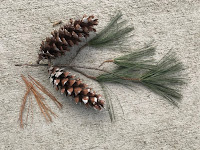 |
| White pine needles and cones |
The big thing to remember for identifying Eastern White Pine is to look at the branches:
Do they grow in a circle, like a hoop skirt? A line of branches; space, then another line of branches; space, then another line of branches. It’s called branches in a whorl. The Eastern White Pine has an open, irregular crown, or top, and holds the title of the tallest native conifer of northeastern United States.
The red pine needles are also dark green, but they’re stiff and inflexible. Some species sport clusters of two needles. A Virginia pine is in this class. Red pines have a single trunk that supports a symmetrical, dense and oval crown with up curved branches.
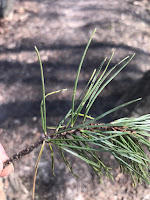 |
| Virginia red pine needles |
We found some Norway spruce growing in our neighborhood. To remember the Norway spruce; think “swamp thing.” The branches blow in the wind. I decided to demonstrate for the children what I meant. I loosely hung my arms from my shoulders and twisted back and forth, to let my hanging arms flop about. The kids thought it was funny. I worried that the neighbors were looking out their windows saying; “What’s that crazy lady doing now?”
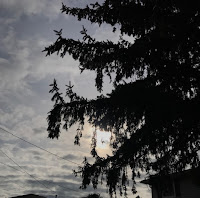 |
| Norway spruce, hang-y pine boughs |
Let’s look at some pine cones. Remember how in my last post about trees I explained that the fruit of a tree is its seeds? How do you tell one pine cone from another?
The Douglas fir tree has a unique pine cone in that it looks like it has little paper tickets sticking out of it. I share a native story about the sly fox and the tiny mouse as well as some western Douglas fir tree facts learned from a park ranger at Olympic National Park in my post “A Rain Forest in the UnitedStates? Are You Crazy, Mom?”
 |
| Douglas Fir cones |
But if you’re looking for dramatic differences in the size of pine cones, look no farther than the western part of the United States. While east coast pines can grow to about 75 and 80 feet tall, we found taller and bigger pines out west. We saw the “giants” of California—the sequoias and the redwoods. You can read of our adventures at Sequoia and Kings Canyon National Parks and of our Redwood National and State Parks at Camping with Five Kids as well.
We learn much from our park ranger hikes and talks. This post is only a summary.
In comparison, the Redwood is the tallest living thing, towering over 300 feet high. The sequoia is the largest living thing in the world. The interesting thing is these mighty giants have no deep taproot like most of the deciduous trees; no root that penetrates straight down into the earth to secure these massive beasts. Most pine trees don’t have tap roots, we discovered. Instead, the redwoods and sequoias have roots that travel beneath the soil for miles in all directions. Impervious to fires and insects because of their thick bark, these giants usually die by toppling because of a lack of tap root.
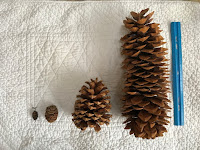 |
| Redwood, Sequoia, bear claw, Sugar Pine |
The sequoia reproduces only through seeds in their cones. And the cones only open when the heat from a forest fire reaches the cones which are hundreds of feet up. The sequoia cone is the size of a chicken egg.
The redwood reproduces from seeds in its tiny, 2-inch cone. However, the redwood can also reproduce by becoming a “mother log” when it topples. The toppled tree sprouts new growth from burls, roots, even cut stumps.
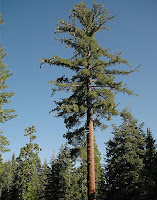 |
| California Sugar Pine tree |
It’s the Sugar Pine out in California that has the huge pine cone in my photo. While the sugar pine is towering, it’s not as massive as the sequoia or redwood tree.
I don’t pretend to be an expert naturalist. This is only a quick overview of what my family has learned about conifer trees on our many adventures camping with kids. Here is a good short post on the difference of pine needles.
I hope you’ve learned something new by reading this post. Please feel free to share any knowledge you may have about nature or pine trees here at Camping with Five Kids. It would truly be appreciated. Enjoy your weekend!







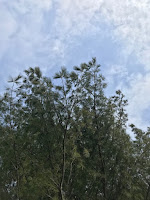
This was very interesting. "White Pines have 5 long needles in a cluster. W-h-i-t-e, 5 letters; 5 pine needles.
Red Pines have 3 long needles in a cluster. R-e-d, 3 letters; 3 pine needles." I definitely learned something new. Great post!
Thank you so much, Michelle, for your kind words. It is truly a pleasure seeing you here at Camping with Five Kids. I always hope to enlighten others with my blog posts. Have a great weekend!
Hi Victoria Marie – it's great you do all these things with the kids – I'm sure they learn as do you – I know I would be … cheers Hilary
Hi Hilary! It’s great to see you at Camping with Five Kids. Yes, my family learns a lot on our travels. I'm hoping the kids like to learn something new as much as I do. All best to you, Hilary! And thanks so much for your note here at Camping with Five Kids. Enjoy your weekend!
it is really helpful. the information in this article is satisfied me. And the information it is very interesting. Thanks for this kind of article.
wood tools
Hello and welcome to Camping with Five Kids! I'm so glad you stopped by and left a note. It's greatly appreciated. Thanks for your kind words. All best to you!
"It's a rather interesting topic. We can pick up some life experience from here. It's a common knowledge that it's hard to bring up your kids. Moreover, if you combine your social life with studying, it's super hard. If you are looking where to buy a term paper online this site will meet all your requirements.my adventure tips
"
Hello and welcome to Camping with Five Kids! I'm so glad you stopped by and left a note. It's greatly appreciated. Thanks for your kind words. I hope you find these posts helpful. Have a happy and healthy 2020!